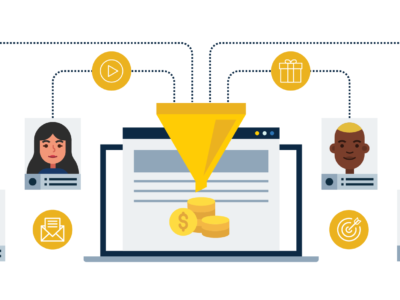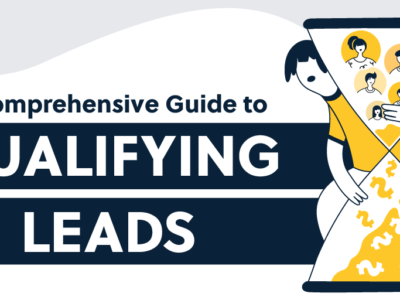What Is Lead Scoring?
Sales and marketing teams use lead scoring to assess the worthiness of leads and future consumers by assigning values to them based on their behavior and interest in their products or services. The “value” of each lead varies for every firm but is typically defined by the level of interest the company generates or its position in the purchasing cycle. Companies use point-based systems to classify leads, or simply call them “hot,” “warm,” or “cold” based on previous contacts.
The initial aim of companies is to attract sales leads or prospects into their pipeline. But after they’ve collected numerous leads, it’s critical for them to focus on the prospects who are most interested in purchasing. Luckily, this is where lead scoring comes in handy.
5 Best Practices to Set Up Your Lead Scoring System
1. Align Sales and Marketing Teams
Traditionally, marketing’s duty has been to find prospects and pass them on to the sales team However, many sales teams frequently express dissatisfaction with the quality of these leads. This can quickly devolve into a toxic blame game in which one department holds the other responsible for the lack of conversions.
The separation is ultimately due to a lack of common data resources and inadequate communication. It will be impossible for either the sales or marketing teams to accomplish their jobs correctly if they are unaware of the underlying plans and execution tactics.
According to research, successfully deployed deal desks have been shown to shorten sales cycle times by up to 40% and increase sales productivity by up to 20%.
Furthermore, deal desks may cut sales cycle times by 25–40%, increase sales productivity by 15–20%, and boost company profitability by 5–10%.
A deal desk gives salespeople the information, productivity tools, and guidance they need from the marketing team to cover all of their bases and move customers through the sales cycle. In short, deal desks help ease communication between sales and marketing teams which increases sales efficiency and helps to identify viable leads more quickly.
Closing sales is significantly more effective when marketing and sales plans are based on the buyer’s journey and behavioral data. In reality, these days, the great majority of customers want firms to use their data to customize interactions and deliver relevant information. To that end, sales team collaboration is an avenue that cannot be ignored.
Companies that successfully bridged the sales and marketing objectives outperformed their competitors to convert leads and meet growth targets. According to Marketo’s analysis, aligned organizations had 67 percent higher conversion rates and produced over 209 percent more income from their leads.
2. Leverage Negative Scoring and Score Degradation
Many marketers don’t employ even the tiniest amount of lead score degradation. If your leads have done nothing for a specific amount of time, say three months or longer, you may wish to give them a bad score.
Also, increasing a lead’s score for certain conduct (downloading a case study, attending a webinar) shouldn’t be permanent. Score inflation can occur if the deterioration of score value is not employed.
Similar to the Negative Lead Score, Score Degradation assists firms in identifying substandard Low-intent Leads and focusing on more valuable, High-quality Leads. Businesses must understand which behaviors should cause point degradation in order to benefit from Score Degradation.
Reversing the point system used for Implicit Scoring is a typical method used by many firms. If a Lead receives 10 points for signing up for a newsletter, they will lose 10 points if they unsubscribe.
3. Determine the Lead Scoring Threshold
The point value at which a prospect is judged Sales-ready is referred to as a Lead Score Threshold. When the Lead Score hits or surpasses this threshold, it is classified as a Marketing Qualified Lead (MQL) and forwarded to Sales to close the transaction.
However, getting the threshold value properly is critical. If it’s too low, and leads are qualified too soon, the sales process becomes considerably more complicated, because the leads aren’t ready to pursue yet. However, if the price is too high, you risk losing the lead to a rival because Sales took too long to reply.
If a Lead seeking a product demo is the best predictor of eventual conversion into a sale, the Lead Score Threshold should be set so that every Lead asking for a demo is awarded enough points to become an MQL right away.
4. Assign Positive Scores for Customer Actions
How a lead interacts with your website might reveal a lot about their willingness to buy from you. Take a look at the people who become clients as a result of your leads: Which deals did they take advantage of? What was the total number of offers they downloaded? Before becoming a client, which pages — and how many pages — did they view on your site?
Leads who viewed high-value sites (such as price pages) or filled out high-value forms may receive better lead scores (like a demo request). Similarly, you may provide better ratings to leads who have visited your site 30 times rather than three times.
A visual approach was utilized by Cyberclick, an online marketing and digital advertising agency, to match a lead’s amount of website activity to the lead’s demographic profile. The best candidates for conversion are leads with a profile that makes them a strong fit for the firm and who have interacted substantially with the site, whereas poor leads did not interact with the company and the website.
5. Monitor Conversion Rates
To determine which marketing initiatives result in conversions across the funnel, run an attribution report. You can fine-tune your funnel and expedite your lead scoring process by looking at the actions and scores of each conversion.
You might give individuals who download material that has historically turned people into leads a specific amount of points, and those who download content that has traditionally converted people into customers a larger number of points.
You have no idea how interested someone is in buying from you if they have signed in to receive emails from your firm. On the other hand, open and click-through rates will offer you a far better picture of their degree of interest. Your sales staff will be interested in knowing who opened each email in your lead nurturing series, as well as who always clicked through your offer promotion emails. With higher open rates, you also have to work on reducing email bounce rate. This can be achieved with the help of an email verification tool by firstly checking email IDs validity.
Leads who click through on high-value mailings, such as demo offers, may also receive a better lead score. Here’s an example of a lead scoring system based on email engagement:
| Action Taken by Email Recipients | Lead Score |
| Open your email | +5 points |
| Click on the link in your email | +10 points |
| Sign up to attend your webinar | +20 points |
| Download a resource | +10 points |
| Provide email in exchange for a discount | +5 points |
| Not responding after more than 3 emails | -25 points |
Let’s look at a regular conversion and sales process:
Conclusion
There is no such thing as a one-size-fits-all strategy to lead scoring. Each company is different, and so are its lead scoring model requirements. Determine which indications indicate a lead’s strong desire to purchase your goods or service. Then you may give such activities and demographics larger lead scores.






